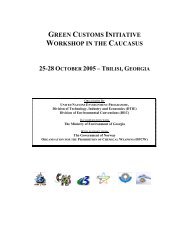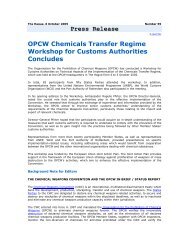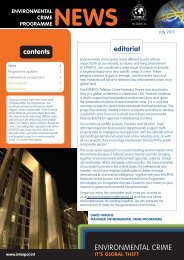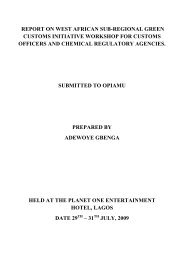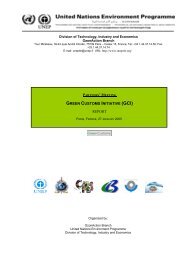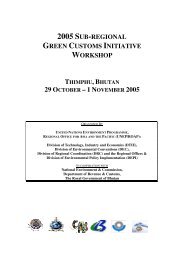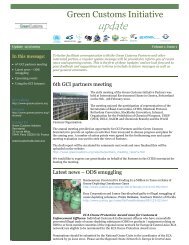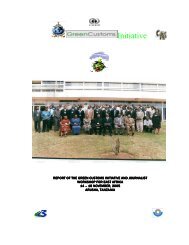EIA, "System Failure" - Green Customs Initiative
EIA, "System Failure" - Green Customs Initiative
EIA, "System Failure" - Green Customs Initiative
Create successful ePaper yourself
Turn your PDF publications into a flip-book with our unique Google optimized e-Paper software.
ILLEGAL TRADE IN ELECTRONIC WASTE<br />
THE GROWING PROBLEM OF<br />
ELECTRONIC WASTE<br />
Electronic waste, or e-waste, is the common<br />
term for electronic goods at the end of<br />
their ‘useful life’. Computers, mobile<br />
phones and televisions are all types of<br />
electronic goods classified as hazardous<br />
waste under the Basel Convention,<br />
an international treaty regulating crossborder<br />
trade in harmful waste.<br />
Due to the proliferation of electronic<br />
devices and accelerated technology<br />
advances, an increasing amount of<br />
e-waste is created every year. It is the<br />
fastest-growing waste stream in the UK,<br />
with more than one million tonnes<br />
generated annually. 1 Globally, the United<br />
Nations Environment Programme (UNEP)<br />
estimates annual production of e-waste to<br />
be 50 million tonnes, of which only 10 per<br />
cent is recycled. 2<br />
E-waste can be highly hazardous to both<br />
the environment and human health due to<br />
the substances it contains. A computer<br />
processor has an array of dangerous metals<br />
and chemicals such as antimony trioxide,<br />
polybrominated flame retardants, selenium,<br />
cadmium and mercury. Cathode ray tubes<br />
(CRT) found in older-style bulky TVs and<br />
desktop computers often contains large<br />
amounts of lead. As well as potentially<br />
harmful materials, e-waste may also<br />
contain small amounts of valuable metals<br />
such as gold and copper.<br />
A range of regulations at the international,<br />
regional and national levels govern trade<br />
in e-waste. The intent is to promote safe<br />
recycling of broken electronic equipment<br />
and to enable legitimate trade in used,<br />
working equipment. In reality, huge<br />
quantities of discarded e-waste end up<br />
being illegally traded around the world.<br />
The European Union, despite strong<br />
legislation, is a major source of e-waste<br />
which is illegally exported and dumped<br />
in developing countries. An estimated<br />
75 per cent of e-waste generated in the<br />
EU, equivalent to eight million tonnes a<br />
year, is unaccounted for. 3<br />
The destination countries do not have the<br />
infrastructure to recycle e-waste safely.<br />
Instead, it is processed manually in scrap<br />
yards with no consideration for health<br />
and safety. The e-waste is stripped down<br />
to components by hand. Copper wires<br />
are bundled and set alight to remove<br />
flame-resistant coatings, emitting toxic<br />
dioxins; CRT monitors are smashed with<br />
hammers, releasing plumes of lead and<br />
ABOVE:<br />
Children working at an<br />
e-waste dump in Ghana.<br />
© <strong>EIA</strong><br />
1



